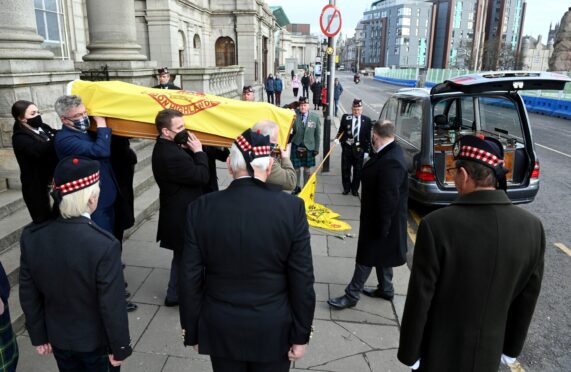Alex Sim, a former Gordon Highlander and El Alamein veteran, has died just short of his 100th birthday.
His coffin was piped out of St Mark’s Church, Aberdeen, and past a guard of honour formed by members of the Gordon Highlanders’ Regimental Association.
Alex was a 20-year-old carpenter from Turriff when he took part in one of the Second World War’s most significant battles.
A soldier with 5th/7th Battalion, he later participated in the invasion of Italy and the Allied drive north into Austria.
He ended the war looking after Nazi prisoners at British internment camp 373 at Wolfsberg, Austria.
On his return to the UK in 1947, Alex went on to serve in the TA for 20 years before becoming an army cadet officer.
In later life, he was a volunteer at The Gordon Highlanders museum in Aberdeen.
Turriff born
Alexander Sim was born in Turriff in April, 1922, the eldest of five children of Alfie and Agnes Sim (nee Hay).
He was educated in Turriff and when he left school he began a carpentry apprenticeship.
At the age of 16 in 1937 he joined the TA but when war broke out in 1939, he was too young to join the British Expeditionary Force to France.
Expeditionary force
Many of the young Gordons who did travel with the BEF were taken captive after the surrender at St Valery and spent their war years in prisoner of war camps.
After two years of home duties and training for combat, Alex boarded the troopship SS Stratheden. It rounded the Cape of Good Hope and spent a week in Durban before sailing up the Suez Canal to Egypt.
When Alex got to Cairo, one of his first tasks was to escort Italian prisoners who were under the control of South African forces.
To his astonishment his eyes met a classmate whose parents had run an ice cream and chip shop in Turriff but had returned to Italy just before the war.
Recognition
Alex and the Italian prisoner recognised each other but did not exchange words for the prisoner’s own safety.
In October 1942, The Gordons, part of the 51st Highland Division and the 8th Army, engaged and defeated Rommel’s Axis forces at the Battle of El Alamein.
Alex, in an interview with The Press and Journal in 2012 said of the battle: “Something like that changes your attitude.
“You get more independent, more confident, more bolshy maybe. For most people, you grow up, you go to school and you go to work and you do what you are told. But when you come out of something like that, you know what you are capable of.”
Advance
After a 2,000-mile march with Allied troops across North Africa, Alex saw action during the Italian campaign including at the Battle of Sferro in Sicily. He later discovered he featured in a painting of the battlefield by Dundee artist Ian Eadie.
When Allied forces pressed forward into Austria, Alex was sent to work in a British internment camp housing Nazi prisoners.
He learned to speak German and at Christmas, the prisoners asked him to sit for a portrait. It was painted by Dr Gabriel Engler, an artist responsible for some of the Third Reich’s propaganda imagery.
When he was due to return to the UK, Alex did not have room for the framed painting in his kit bag and left it in a locker.
However, when he returned to Turriff, he found a fellow Scot had recognised him from the portrait and had posted it on.
Falling in love
Not long after being demobbed, he met his future wife, Madeline. Her father had been a typesetter with Aberdeen University Press. He holidayed in Turriff where Alex’s mother took in boarders during the Aberdeen Trades Fortnight.
The couple married in St Mark’s Church, Aberdeen, in 1950. They had four girls; Patricia, Lesley, who died in 1986, Lorna and Valerie.
Although a time-served carpenter, Alex undertook joinery work on Scotland’s hydro-electric dam building projects of the 1940s and 1950s. The landscapes around these highland locations had a lasting impression and Alex chose the area for his and Madeline’s honeymoon.
By the late 1960s, Alex had moved to indoor work as a clerk with the water board. He later joined the architects’ department of Grampian Regional Council.
Alex had an active retirement, volunteering at The Gordon Highlanders museum and working as the beadle at St Mark’s Church.
He enjoyed gardening, the library, art galleries and using his bus pass visiting his sister Bett in Turriff.
Return journey
After being widowed in 1995, he travelled to Australia three times to visit his sister Peg and in 2004 made a return to North Africa to visit the El Alamein war graves.
His daughters related: “He lost many close friends and comrades in the battle, young men from the north-east.
“He was such a quiet man and treated the visit with great respect. As well as the Allied graves he made a point of visiting the German war graves.
“After all, as he said, they were sons, brothers, husbands, just like us.”




